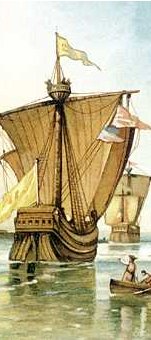The Effects of industry on ecology Anu Murthy
Andrew C. Isenberg is a professor of history at Temple
University. He is also the author
of The Destruction of the Bison: An Environmental History and is a former
fellow of the Huntington Library
and the Shelby Cullom Davis
Center for Historical Studies.
The Californian environment has
been altered by settlers many times to meet the needs of technological
advances. The 1849 gold rush, however, has had one of the most significant
influences on California��s ecology.
Before the 1850s many Native American tribes cultivated its diverse
terrain, and California remained
virtually free of industry and technology. The gold rush changed all of this.
With the discovery of gold and the end of the Mexican War, came the American
desire to control an environment ��composed on numerous and complex interconnections��1. New mining practices
themselves caused the creation of many other industries, such as commercial
agriculture, hunting, fishing, railroads, and lumber. Bonanza farms�Xlarge
ranches dependent on industry�Xprogressed and quickly replaced older
agricultural methods. Trying to quicken the development of natural resources,
industrialists attempted to compensate for the high costs of capital and labor.
Their goal of conquering California��s
distinct ecology had various effects on the environment. Andrew C. Isenberg��s Mining
California: An Ecological History explores these
consequences and analyzes the gradual industrialization of California.
Chapter 1 of this book deals with the
effects of hydraulic mining on the environment. The few years after the
discovery of gold, settlers used laborious techniques to unearth this valuable
metal. Some of these procedures included panning, makeshift dams, and simply
digging. Before hydraulic mining, rivers posed a threat to industry. In the
spring, high waters prevented people from scouring gravel. In the summer,
streams receded and miners could not divert the water as they pleased. Dams
often collapsed and manmade reservoirs were generally unreliable. Therefore,
industry��s failure to control waterways made the economy run on credit. Banks
closed and currency depended on gold or foreign coins. Hydraulic mining, a
system that uses pressured water to wash hillsides, trap gold, and rinse away soil
and gravel, allowed miners to take charge of waterways. One of its major
consequences was the steady decline of independent prospectors. For investors,
hydraulic mining was beneficial in two ways. It greatly ��reduced the high costs
of labor in the gold country.��2 Due
to the deterioration of independent prospectors, gold country was employed by
wage laborers. Secondly, ��the hydraulic system extended a measure of human
control over the dynamic hydrology of the California
gold country.��3 The
unpredictable weather often made investors hesitant to commit money to mining
until the invention of hydraulic mining. However, miners soon learned to extend
their hegemony over waterways and, consequently, attracted investors to offset
the costs of labor and capital. Hydraulic mining also had negative effects on
the environment. The flushed debris from washed soil and gravel polluted the
waterways that led straight into the San Francisco
Bay. The debris destroyed the
spawning grounds of salmon and other food options; much of the mercury used in
hydraulic mines also found its way into rivers. This toxin poisoned available
water for humans, livestock, and fish. The California
legislature�Xnot yet organized due to the 1846 Mexican War�Xdid nothing to
counteract the destruction of the environment. In fact, legislation protected
industry��s right to discard wastes in public waterways. By the 1850s, courts
gave prospectors the privilege to enter public lands settled by farmers. Judges
regarded courts as merely ��a social tool that could promote change.��4
The machinery of hydraulic mining promoted other industries. A simple
nozzle at the end of each canvas hose, called a moniter,
resulted in an expanded iron industry. Capable of shooting water at great
speeds, moniters were kept running day and night. The
increased demand for this improved nozzle helped the iron industry profit.
Although hydraulic mining did inflate other commercial areas, its effects on
the environment were highly destructive.
The capital of California
underwent many alterations because of the gold rush. Isenberg describes these
alterations in Chapter 2. Before gold discovery, Sacramento
contained many villages, but no cities. Substantial settlements were based on
the coast, but few metropolises existed on the interior. Most coastal towns
��served as ports and way stations for hunters who preyed on aquatic mammals.��5 Major cities were located
at the confluence of major rivers; in fact, cities operated more like
joint-stock companies than actual residential areas. Merchants and speculators
acted as investors and looked to expand their company commercially. Municipal
governments, made up of these investors, formed their board of directors. As
cities started to need better transportation, steam powered vessels and
railroads developed, and citizens became more dependent on steam. Because of
this reliance, the lumber industry also expanded. This growth, however,
destroyed Sacramento��s dense
forests and had other damaging effects on the environment. With the attraction
of merchandise and capital came the rise of disease. Between 1849 and 1850, a
cholera epidemic swept Sacramento.
City governments were hesitant to give resources to the poor and those without
property. The influx of diseased citizens resulted in a dirty and crowded area.
Like hydraulic mining, rapid urbanization had mostly negative effects on Sacramento.
Isenberg describes the effects of
gold discovery on the lumber industry in Chapter 3. Lumber was mainly used for
fuel and construction. It attracted many independent prospectors who looked for
employment after the expansion of hydraulics. Swept away by the excitement of a
new and rising lumber industry, loggers, like many other people, shifted the
burden of labor cost and capital on the environment. Logging techniques quickly
depleted forests and overwhelmed the market. During the mid nineteenth century,
federal legislation hoped to spur the economy by shifting public land into
private ownership. In 1878, ��the federal government accelerated the
privatization of forest lands with the passage of the Timber and Stone
Act�Kwhich opened forests on the public domain to sale for a small fee.��6 Steam power and railroads
exposed remote parts of redwood forests. The rise of technology forced loggers
to cut more trees to balance the amount of money spent on machine investment.
Like other industries, the lumber industry took its toll on the environment.
The timber in redwood belts started to decline and grasses and shrubs crowded
emerging trees out of the area. Deforestation created more river sediment which
in turn caused a sharp drop in migrating fish. The lack of canopy triggered
solar radiation and water temperatures to rise. The expansion of the lumber
industry did help the economy but as a consequence of this development, the environment
suffered.
As Isenberg starts the second half
with the decline of Californios, he shifts his study
to industry��s influence on farming. Californios, who
were married to Mexican elites, often owned large ranches on the coast that
were ideal to produce beef. Intermarriage encouraged families to cooperate in
business. Californios gained immense commercial power
from the demand for beef. However, in the 1860s, Californio
dominance receded. Three main reasons caused this decline. First, Californios were unable to adapt after the Mexican War.
Newcomers, such as Anglo-Americans had superior economic vigor and ignored the
property rights of Californios. Second, conquests of
their property reduced Mexican-Americans to segregated wage laborers. The rise
of Anglo-Americans ��destroyed the large estate owners of southern California
and led to the�Kproletarianization of Mexican-Americans.��7 Third and most important, southern California��s
environment was drought prone. Rancheros refused to adapt to an intensive stockraising system, where farmers cultivated hay and
constructed fences. Instead they clung to an extensive stockraising
system, where the herds were let over large areas. This technique left
rancheros dependent on grasslands for their livestock��s health. Many Californios were land rich and cash poor as the beef market
slumped. They were able to sustain by selling cattle hides and tallow to Britain
and the United States.
They also compensated for the lack of labor by hiring Native Americans.
However, intensive stockraising made rancheros
vulnerable to well-financed competitors. By the 1850s, the decline in the beef
market led to overgrazing. Ranchers could not sell their livestock; buyers were
not inclined to trust southern California
wool either. In the 1860s, cowboys, more cooperative with financers than
ranchers were, replaced Californios. Their
settlements also failed due to the 1863 drought and the 1864 grasshopper
infestation.
The fifth and last section of this
book deals with enclosure of Native American lands. In 1864, the Modoc tribe
assented to cede their California
lands and live on a reservation in Oregon.
Some Modocs stayed and worked on ranches but ranchero
opposition forced the Californian Army to drive remaining Modocs
out of California. This particular
tribe was not ignort of the Americans. They were
��highly acculturated to Euroamerican mores�K [and] they enjoyed good relations with the townspeople.��8 However, the discovery of gold
and ranch extensions pushed the Modocs farther away
from their homeland. Many tribes shifted into the wage labor market. Native
American women were often forced to become domestic servants or prostitutes.
The rise in prostitution prompted widespread sexually transmitted diseases,
which in turn caused a decline in Modoc population. Before the influx of Euroamerican settlers, the Modoc tribe dominated the
plateau. They relied on the diversity of resources and planned their lives
around the seasons. By the 1840s, however, Euroamericans
began to inhabit Oregon
territory, thereby disrupting the Modoc trade patters. The gold rush and its
new technologies proved to be serious blow to the Modoc tribe��s sustenance
strategies. In 1873, the Modoc War ended and Euroamerican
settlers gained control of the lands. They overpowered most of the Native
Americans and concluded the enclosure of the plateau.
Isenberg��s thesis states that
nineteenth-century industrialism in California
is based mainly on the struggle to control the environment. Through his
examples of how ��industrialism ultimately affected every part of California��s
environments,�� Isenberg implies that settlers�� desire for ecological
power damaged the environment as well as the settlers�� lives.9
In each chapter he begins with a description of a way
in which industry expanded during the years of the gold rush. Isenberg then
transitions into a subtle disparagement of industrialism��s pernicious effect on
California��s rich environment.
For example, Isenberg portrays the discovery of hydrology. He explains how
dominance over waterways was helpful to settlers, but he never lingers for long
on its benefits. Even though hydraulic mining seems like an efficient
technique, Isenberg focuses most of chapter on the negative effects of
hydrology on the environment. In the last section, Isenberg connects racial
discrimination of Native Americans with environmental destruction. Isenberg��s
thesis covers various areas of California
during the gold rush years, yet these subjects are all tied together by a
common message: American settlers�� fight for industrialism harmed the
environment.
Andrew C. Isenberg is a history
professor who has written copious books on America��s
environmental history. Possibly influenced by the popular discussion of global
warming and modern day environmental problems, Isenberg��s book shows how
technology has detrimental effects on the Californian ecology. Isenberg assumes
that environmental predicaments still trouble American society today. His
description of past attempts to conquer nature serve as a warning to the modern
world that damage to the environment is the same thing as damage to the
society. Isenberg hopes that modern society can learn from early settlers who
��repeatedly discovered that their alterations of nature were not without
consequence�KEuroamericans reinscribed
the political ecology of California
upon the landscape of the West.��10 Isenberg,
being a history professor and an environmentalist, knows the severe outcomes of
ecological destruction. Isenberg wants readers to avoid history��s mistakes and
not try to overpower nature. Published in 2005, Isenberg��s
book falls into Neo-Conservative historiography. Characteristic of this
category, Isenberg views the effects of the gold rush objectively. Little of
his personal opinions are present and there is no ideology. In light of recent
importance given to the planet��s ecology, Isenberg retells history so that
Americans today will realize the devastating effects of environmental
pollution.
Peter Coates, an environmental
history professor, reviewed Isenberg��s book in the Journal of American
History. Largely in praise of this work, Coates remains impressed by
Isenberg��s sole focus on Californian history. He complains that ��new western
[history] tend[s] to marginalize the state��11,
thereby stressing that Isenberg��s focus is necessary for a complete
understanding of western ecology. He compares and contrasts this work to other
historians�� pieces, implying that Isenberg��s research on the subject is
accountable. Coates also specifically comments on Isenberg��s use of the Modoc
tribe. Impressed by Isenberg��s insight, Coates commends the way the author
employs Native American relationships to show how enclosure also affected the
environment. Coates expresses his approval of Isenberg��s thesis, stating that
this book is a ��welcome addition to the growing number of studies on the
environmental history of mining in the American West.��12
Coates moves on to applaud Isenberg��s literary style.
Isenberg��s work is extremely
informative and well-written. He explains sophisticated parts of California��s
history in comprehendible language. Connecting each section of his book to
convey a common message, Isenberg does more than simply relate stories of this
state��s past. He delves deeper in his studies and carefully investigates the
many causes of California��s
environmental deterioration. The fact that Isenberg can bond various subjects,
ranging from hydrology to Native American relations, into one piece and
intertwine their implications is truly impressive. Isenberg��s constant
reference to various historians, such as J. Willard Hurst13,
a legal historian, and Leonard Pitt14,
who specializes in Californio history, reflects his
deep knowledge in the area of environmental history. The references also serve
as a change for the reader; instead of an avalanche of his own opinions,
Isenberg offers diverse points of view and analyzes the effects of California��s
industrialization.
California��s
rate of industrialization was heavily dependant on eastern United
States. Before the days of hydraulic mining,
independent prospectors struggled to attract investors from the rest of United
States and Europe.
They worried that ��investors were wary of committing capital to California
placer mining until the industry had tamed the volatile environment.��24
Because of the high costs of labor and capital, placer miners lacked
investments and had no means to contract more efficient machines. The
Industrial Revolution in the East and Midwest gradually
seeped through the country and finally reached California.
Because of the Industrial Revolution, California
started to conquer the environment, thereby gaining the trust of outside
investors. The Mexican War also had a profound effect on California.
The Californios had long dominated southern California
but the influx of Euroamerican settlers terminated
this supremacy. After the Mexican War, Americans from the East and Midwest
completely ignored the Californios�� property and
squatted on their estates. The rancheros refusal to adapt to these changes
caused the end of their agrarian lifestyle and paved the way for industry.
Although California
was influenced by happenings in the East, its events were also distinctive from
the rest of the country. Unlike the East that had distinctive regions of
industry or agriculture, California
contained both simultaneously. The diverse environment of mountains, deserts,
forests, and coastal areas allowed California
to try its success in ranches and then industry. Another difference was
individuals�� reaction to the ecology. Americans in the East took whatever the
surroundings offered, thereby creating opposite cultures centered in the North
and in the South. On the other hand, Euroamericans
who settled in California looked
to conquer the land and alter it according to their needs.
The
1849 gold rush changed California
drastically. Initially a territory of
Mexican- American cattle ranches, California
evolved into a populous state that saw the replacement of agriculture with
industry. Isenberg��s novel reveals the ecological effects that technology had
on the once diverse Californian environment. Although an industrial revolution
seemed like the correct event for a growing area, Isenberg shows how industry
had a reverse effect. New advancements not only proved to be dangerous to the
environment, but their effects on the environment hurt settlers also. Euroamericans��
battle against the environment ended as settlers realized that they must also
��set the terms for the preservation of the natural environment.��15
This lesson that Californians learned is the message that Isenberg wishes to
convey. Control of the environment does not necessarily lead to success; the
environment should be respected and used to aid society.
1. Isenberg, Andrew C. Mining California:
An Ecological History. New York:
Hill and Wang, 2005 15.
2. Isenberg, Andrew C. 24.
3. Isenberg, Andrew C. 24.
4. Isenberg, Andrew C. 33.
5. Isenberg, Andrew C. 54.
6. Isenberg, Andrew C. 81.
7. Isenberg, Andrew C. 107.
8. Isenberg, Andrew C. 134.
9. Isenberg, Andrew C. 21.
10. Isenberg, Andrew C. 177-178.
11. Coates, Peter. "Mining California:
An Ecological History." Environmental History 11(2006): 629-630.
12. Coates, Peter 630.
13. Isenberg, Andrew C. 34.
14. Isenberg, Andrew C. 104.
15. Isenberg, Andrew C. 177.










